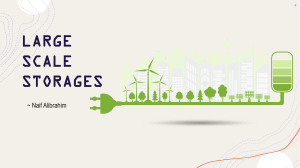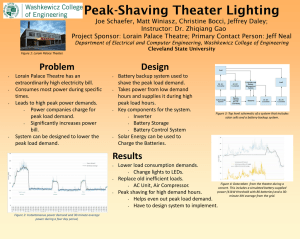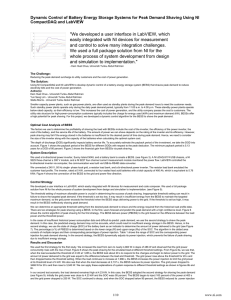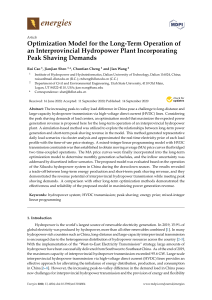Peak Shaving – A potential Energy Storage Application
advertisement
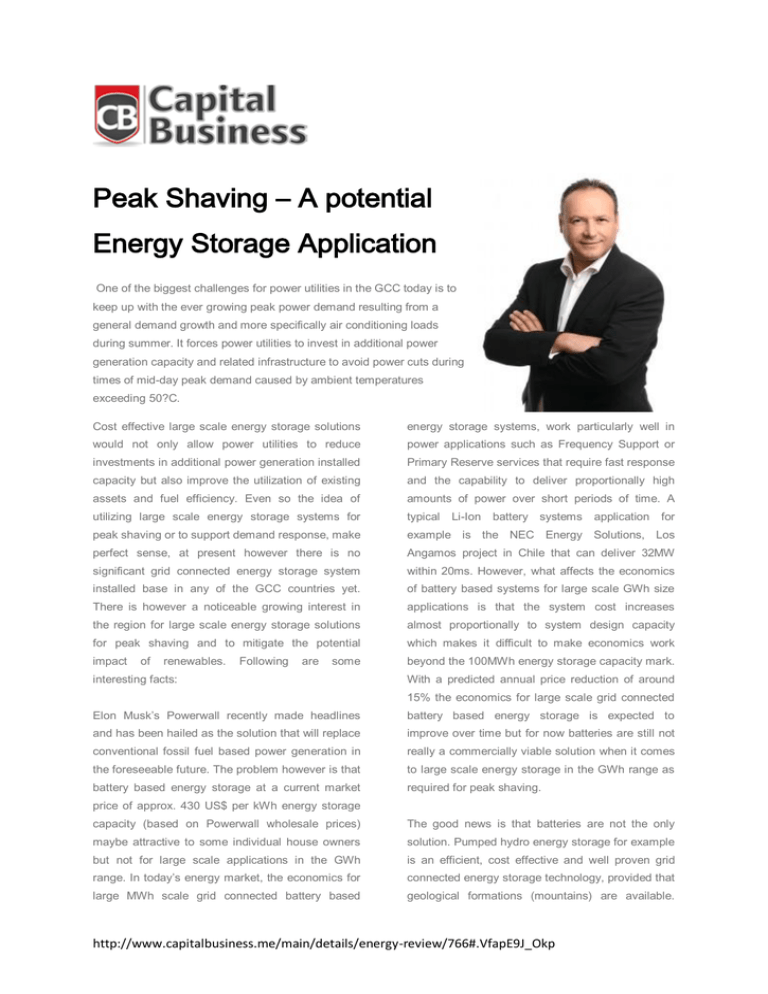
Peak Shaving – A potential Energy Storage Application One of the biggest challenges for power utilities in the GCC today is to keep up with the ever growing peak power demand resulting from a general demand growth and more specifically air conditioning loads during summer. It forces power utilities to invest in additional power generation capacity and related infrastructure to avoid power cuts during times of mid-day peak demand caused by ambient temperatures exceeding 50?C. Cost effective large scale energy storage solutions energy storage systems, work particularly well in would not only allow power utilities to reduce power applications such as Frequency Support or investments in additional power generation installed Primary Reserve services that require fast response capacity but also improve the utilization of existing and the capability to deliver proportionally high assets and fuel efficiency. Even so the idea of amounts of power over short periods of time. A utilizing large scale energy storage systems for typical peak shaving or to support demand response, make example is the NEC Energy Solutions, Los perfect sense, at present however there is no Angamos project in Chile that can deliver 32MW significant grid connected energy storage system within 20ms. However, what affects the economics installed base in any of the GCC countries yet. of battery based systems for large scale GWh size There is however a noticeable growing interest in applications is that the system cost increases the region for large scale energy storage solutions almost proportionally to system design capacity for peak shaving and to mitigate the potential which makes it difficult to make economics work impact beyond the 100MWh energy storage capacity mark. of renewables. Following are some interesting facts: Li-Ion battery systems application for With a predicted annual price reduction of around 15% the economics for large scale grid connected Elon Musk’s Powerwall recently made headlines battery based energy storage is expected to and has been hailed as the solution that will replace improve over time but for now batteries are still not conventional fossil fuel based power generation in really a commercially viable solution when it comes the foreseeable future. The problem however is that to large scale energy storage in the GWh range as battery based energy storage at a current market required for peak shaving. price of approx. 430 US$ per kWh energy storage capacity (based on Powerwall wholesale prices) The good news is that batteries are not the only maybe attractive to some individual house owners solution. Pumped hydro energy storage for example but not for large scale applications in the GWh is an efficient, cost effective and well proven grid range. In today’s energy market, the economics for connected energy storage technology, provided that large MWh scale grid connected battery based geological formations (mountains) are available. http://www.capitalbusiness.me/main/details/energy-review/766#.VfapE9J_Okp The most important cost factors that determine the of pumping the water up a mountain, it is used to lift economic feasibility are the grid connection and a large rock, which has been cut out of the ground. water related infrastructural construction cost. The hydraulic rock system is specifically well suited Identification of suitable locations which require a for large scale energy storage systems in the GWh minimum in infrastructure related investment is key range as the cost per kWh energy storage installed in the successful development of commercially capacity is dropping by 75% when the size is viable pump hydro energy storage systems. Finding doubled while at the same time energy storage suitable locations however might prove more capacity increases by a factor 16. The estimated challenging than one might expect. An innovative total cost of approx. 150 US$ per installed kWh alternative hydro based energy storage design energy storage installed capacity for a system with called “Hydraulic Rock” recently developed by total design capacity of 8GWh is good news for the Heindl Energy is drastically reducing the challenge energy storage and renewable energy industry and to find the right location by literally putting the might eventually help to make large scale peak classic pump hydro concept upside down. Instead shaving in the GCC a reality. About Claudio Palmieri Claudio Palmieri is the CEO CLS Energy Consultants at The Dubai Multi Commodities Centre (DMCC) and a Technical Director at Clean Energy Business Council (CEBC). He has worked in commissioning, engineering, project management, service, sales, project development and business development for power, renewable energy and Oil & Gas for companies like ABB, MTU and Kharafi National, which included a position on the board of directors of a Solar PV EPC company registered at Masdar, Abu Dhabi. © Capital Business 2015 http://www.capitalbusiness.me/main/details/energy-review/766#.VfapE9J_Okp
